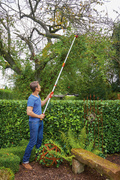WOLF-Garten shrub and tree maintenance from the ground – the ladder stays in the garden shed
Professionals know: Tree maintenance from the ground is the safest. Working from ladders has risks, falls from greater heights lead to severe injuries. Hobby gardeners should think about that as well.
It is generally not necessary to get up into the tree. All tree maintenance tasks can be handled safely and conveniently from the ground. Vario handles that can be extended to up to four metres in length can be combined with tree cutters and cable systems.
Even branches that are very high up can be reached. But it is not just a question of safety. The specialists from WOLF-Garten can advise what is to be cut, and when and how. The best time for pruning shrubs is late spring, and it is important to prune shrubs and trees in a specific way.
It is not necessary for every shrub to be pruned regularly to remain healthy and vigorous. Many evergreens and other well grown shrubs can be left unpruned for longer periods. For example, magnolia and witch hazel are harmed rather than helped by frequent pruning. It is especially important to have sharp tools, because only clean cuts can heal quickly. Diseases and fungi go for the ragged injuries left by blunt blades and so weaken the plant. The exact approach is likewise important: Always cut above a healthy bud and cut back to the trunk or main branch when removing whole branches. The experts have put together ten golden rules:
1. Regularly prune trees.
2. Do not prune at temperatures below –8°C.
3. Only use sharp tools in a perfect condition.
4. Remove all dead and diseased wood and all dried and shrivelled fruits (fruits that have dried out and have been infested by fungi). Disinfect the tool with industrial alcohol after pruning the diseased parts of trees.
5. Light pruning produces little budding, heavy pruning produces heavy budding.
6. Aim for and maintain the desired overall shape of the tree:
• First prune out the weakest leader, and align the stronger ones to it.
• Bring the leaders to the correct angle with regard to the tree.
• The leaders should be emphasised on a strongly growing underlayer in the case of apple, pear and stone fruit trees.
7. Always subordinate fruiting branches to the leaders.
8. Always promote growing, young fruiting branches and cut out old, damaged fruiting branches.
9. Check the trunk and wound treatment.
10. Observe and note the reaction of the tree to the pruning. Take this experience into account when pruning the next time.
- Fichiers:
- Gehoelzpflege_02.jpg5.69 Mi
- 4231_-_Baumpflege_vom_Boden_aus_2014-15_-_DE_02.pdf50 Ki
